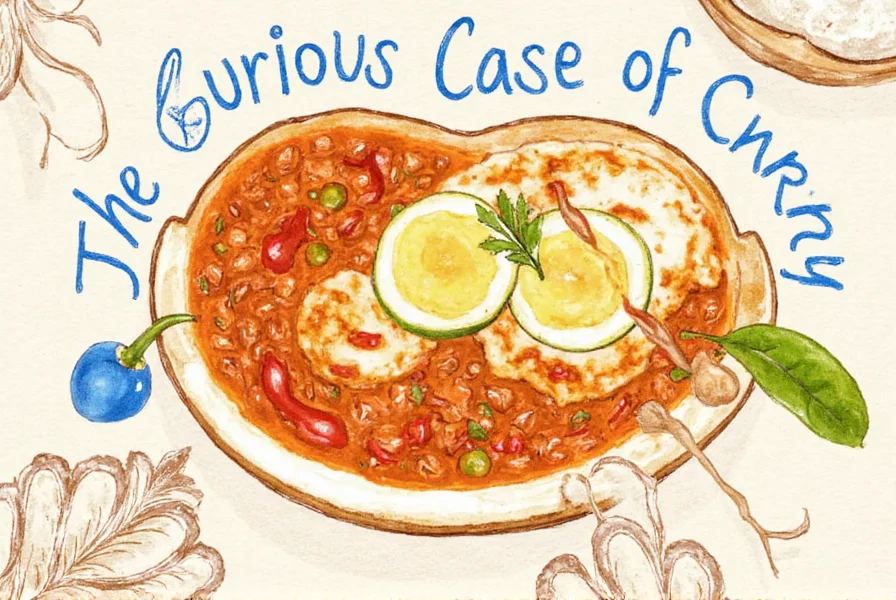Table of Contents
The Origin of the Word 'Curry'
The term 'curry' has a complex etymological history that reflects centuries of cultural exchange. Contrary to popular belief, 'curry' is not an indigenous Indian term but a colonial construct. British colonizers in the 18th century adopted the word to categorize the diverse spiced dishes they encountered across South Asia, simplifying regional variations into a single English term.
While many assume 'curry' derives from the Tamil word kari (meaning 'sauce'), historical records show British East India Company documents used 'curry' as early as 1658 to describe Indian dishes. The term was never used in traditional Indian languages to describe a specific dish—it was a Western label for the complex spice blends and cooking techniques found across India, Sri Lanka, and Southeast Asia.
Historical Evolution of Curry
Curry's evolution is deeply intertwined with trade routes and colonial history. The spice trade between India and Europe introduced ingredients like black pepper and cinnamon to Western palates. However, the modern concept of 'curry' as a single dish emerged during British colonial rule when Indian cooks adapted regional recipes to suit British tastes, creating dishes like 'mulligatawny soup' and 'chicken curry' with reduced spice levels.
By the 19th century, curry powder—a standardized spice blend—was commercially produced in Britain to replicate Indian flavors for home cooks. This industrialization of curry led to the creation of the first curry powder recipes by companies like Sharwood's and Patak's, which became staples in British households and later spread globally.
| Year | Key Development | Historical Evidence |
|---|---|---|
| 1658 | First documented English use of 'curry' in Peter Mundy's travel journal | Etymonline: curry (citing OED) |
| 1747 | Hannah Glasse publishes first English curry recipe in 'The Art of Cookery' | Google Books: Art of Cookery p.185 |
| 1810 | Crosse & Blackwell produces first commercial curry powder | Crosse & Blackwell History |
| 1889 | Sharwood's begins mass-producing curry powder in London | Sharwood's Official Timeline |
This timeline illustrates how 'curry' transformed from a colonial descriptor into a globally standardized product. Notably, these developments occurred outside South Asia, confirming that commercial curry as known today originated through British adaptation rather than direct transmission of Indian culinary practices.
Curry's Global Influence and Cultural Adaptation
Curry's journey beyond South Asia demonstrates remarkable cultural adaptation. In Japan, 'kare' evolved into a thick, sweet curry served with rice, influenced by British naval cuisine. Thai curries developed unique identities with ingredients like lemongrass and galangal, while Caribbean curries incorporated local peppers and coconut milk. Each region transformed the concept to suit local ingredients and tastes, creating distinct culinary traditions under the 'curry' umbrella.
Modern curry dishes like Japanese katsu curry, Jamaican goat curry, and British 'curry house' classics all share a common colonial origin but have evolved into culturally distinct preparations. This global adaptation highlights how 'curry' is not a single dish but a flexible culinary framework shaped by regional traditions.
Linguistic Roots of the Word 'Curry'
Linguistic research reveals that 'curry' has no direct equivalent in Indian languages. The Tamil word kari (meaning 'sauce') was sometimes used in colonial correspondence, but it referred specifically to a type of vegetable dish, not the broad category Westerners labeled 'curry'.
Historical documents show British colonizers used 'kari' as a transliteration of local terms, but they later simplified it to 'curry' for easier pronunciation. This linguistic simplification obscured the diversity of South Asian cuisines, where dishes like masala, saag, and bhuna have distinct names and preparation methods.
Food historian Lizzie Collingham's research in Curry: A Tale of Cooks and Conquerors establishes critical context boundaries: 'The word "curry" is in fact a creation of the English language' when applied to South Asian dishes (Collingham, 2006). This distinction remains essential—'curry' appropriately describes diasporic adaptations like British 'balti' or Japanese 'kare', but misrepresents authentic regional preparations where specific terms like rogan josh (Kashmir) or kaalan (Kerala) denote unique culinary traditions with distinct spice profiles and cooking methods. Applying 'curry' universally erases these critical regional boundaries.
Frequently Asked Questions
Is 'curry' an Indian word?
No. 'Curry' is a colonial-era English term created by British colonizers to describe South Asian dishes. Traditional Indian languages use specific terms like masala, saag, or bhuna for individual dishes, not a single word for 'curry'. Linguistic evidence from the Oxford English Dictionary confirms its first English usage in 1658.
Where did curry powder originate?
Curry powder was invented in Britain during the 18th century as a standardized spice blend for Western home cooks. Indian cuisine never used pre-mixed 'curry powder'—spices were traditionally blended fresh for each dish. The first commercial curry powders were produced by British companies like Sharwood's in the 1800s, as documented in their company history.
Why do people think 'curry' comes from Tamil?
This misconception stems from early colonial records where British writers sometimes used 'kari' (Tamil for 'sauce') to describe Indian dishes. However, 'kari' referred only to specific vegetable dishes, not the broad category of spiced dishes labeled 'curry' by Westerners. Linguistic research confirms 'curry' is a Western invention, with the OED citing its adaptation for English speakers.
Does authentic Indian cuisine have 'curry'?
No. Indian cuisine has hundreds of distinct dishes with specific names like chana masala, palak paneer, or butter chicken. The term 'curry' is a Western simplification that doesn't exist in Indian culinary tradition. Indian chefs avoid using 'curry' when describing authentic dishes, as emphasized by food historians like Collingham in Curry: A Tale of Cooks and Conquerors (p.3).
How did curry spread globally?
Curry spread through British colonial trade routes, with Indian cooks adapting recipes for British tastes. The invention of curry powder in Britain allowed Westerners to replicate 'Indian' flavors at home. Later, Indian immigrants introduced regional variations to countries like the UK, Canada, and the US, where local adaptations created new styles like British 'curry house' dishes and Japanese kare, as shown in the historical timeline.











 浙公网安备
33010002000092号
浙公网安备
33010002000092号 浙B2-20120091-4
浙B2-20120091-4